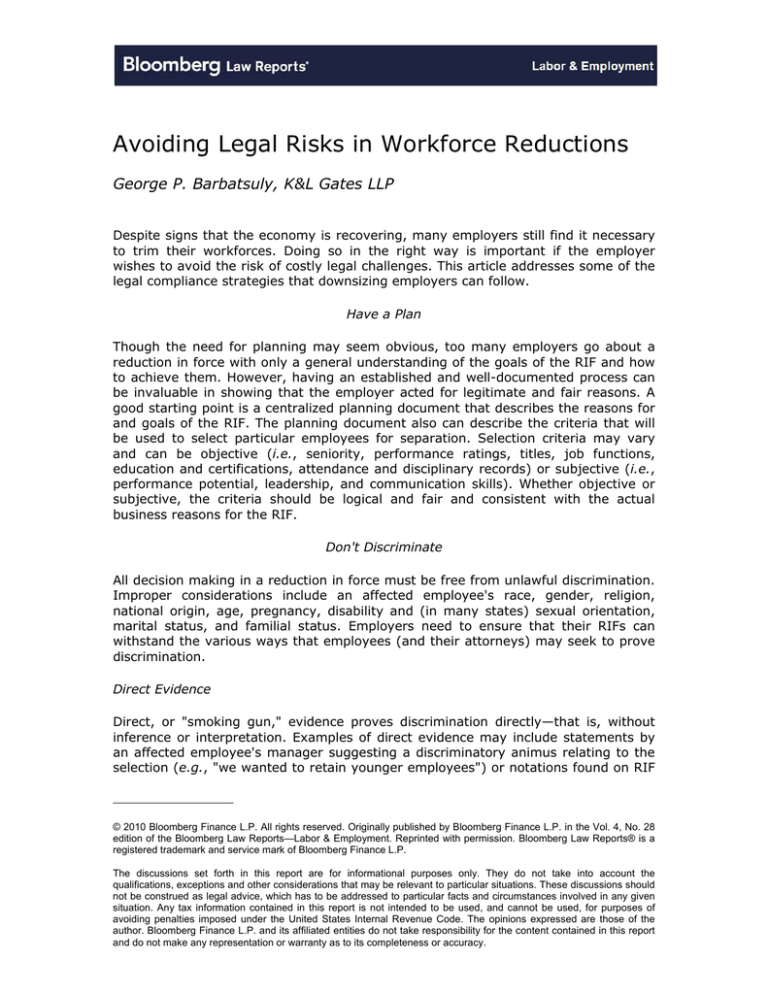
Avoiding Legal Risks in Workforce Reductions
George P. Barbatsuly, K&L Gates LLP
Despite signs that the economy is recovering, many employers still find it necessary
to trim their workforces. Doing so in the right way is important if the employer
wishes to avoid the risk of costly legal challenges. This article addresses some of the
legal compliance strategies that downsizing employers can follow.
Have a Plan
Though the need for planning may seem obvious, too many employers go about a
reduction in force with only a general understanding of the goals of the RIF and how
to achieve them. However, having an established and well-documented process can
be invaluable in showing that the employer acted for legitimate and fair reasons. A
good starting point is a centralized planning document that describes the reasons for
and goals of the RIF. The planning document also can describe the criteria that will
be used to select particular employees for separation. Selection criteria may vary
and can be objective (i.e., seniority, performance ratings, titles, job functions,
education and certifications, attendance and disciplinary records) or subjective (i.e.,
performance potential, leadership, and communication skills). Whether objective or
subjective, the criteria should be logical and fair and consistent with the actual
business reasons for the RIF.
Don't Discriminate
All decision making in a reduction in force must be free from unlawful discrimination.
Improper considerations include an affected employee's race, gender, religion,
national origin, age, pregnancy, disability and (in many states) sexual orientation,
marital status, and familial status. Employers need to ensure that their RIFs can
withstand the various ways that employees (and their attorneys) may seek to prove
discrimination.
Direct Evidence
Direct, or "smoking gun," evidence proves discrimination directly—that is, without
inference or interpretation. Examples of direct evidence may include statements by
an affected employee's manager suggesting a discriminatory animus relating to the
selection (e.g., "we wanted to retain younger employees") or notations found on RIF
________________
© 2010 Bloomberg Finance L.P. All rights reserved. Originally published by Bloomberg Finance L.P. in the Vol. 4, No. 28
edition of the Bloomberg Law Reports—Labor & Employment. Reprinted with permission. Bloomberg Law Reports® is a
registered trademark and service mark of Bloomberg Finance L.P.
The discussions set forth in this report are for informational purposes only. They do not take into account the
qualifications, exceptions and other considerations that may be relevant to particular situations. These discussions should
not be construed as legal advice, which has to be addressed to particular facts and circumstances involved in any given
situation. Any tax information contained in this report is not intended to be used, and cannot be used, for purposes of
avoiding penalties imposed under the United States Internal Revenue Code. The opinions expressed are those of the
author. Bloomberg Finance L.P. and its affiliated entities do not take responsibility for the content contained in this report
and do not make any representation or warranty as to its completeness or accuracy.
documents reflecting an unlawful motive. Effective training of managers who will be
involved in selection decisions is critical to ensuring that a RIF is not tainted with
such direct evidence.
"Pretext" Method
Where direct evidence is unavailable, an affected employee may seek to prove
discrimination indirectly using the "pretext" method. Under this method, the plaintiff
must demonstrate a prima facie case of discrimination by showing, for example, that
he or she was separated while a lesser qualified person outside of the protected class
was retained. The employer then must articulate a legitimate, non-discriminatory
reason for its decision (e.g., business reorganization, cost-cutting, performance,
sales, productivity). Thereafter, the question becomes whether the separated
employee can offer enough evidence to prove that the employer's stated reason for
its decision was a mere pretext for unlawful discrimination. Weaknesses,
implausibilities, and inconsistencies in the employer's stated reasons for the RIF are
all ways that the downsized employee can seek to prove his or her claim under a
pretext theory. Therefore, employers must be consistent—and accurate—in
articulating the reasons for the RIF and for particular selection decisions. An
employer should not, for example, tell a downsized employee that his or her position
is being eliminated as part of the RIF, only to post a vacancy announcement for that
position a short while later. Even small discrepancies in an employer's explanations
can lead to large claims by separated employees under a pretext theory.
Statistical Evidence
Where there is no direct or indirect evidence that a layoff decision was motivated for
a discriminatory reason, downsized employees still have another available avenue to
try to prove their discrimination case—statistical evidence. Under a so-called
"disparate impact theory," a plaintiff may seek to prove discrimination by showing
that an employer's facially neutral RIF policies, procedures, or selection criteria had a
statistically disparate impact on a protected class.
To measure statistical impact, the U.S. Equal Employment Opportunity Commission
and other federal enforcement agencies have adopted a rule that generally considers
a selection rate for any race, sex, or ethnic group that is less than 80 percent of the
selection rate for the group with the highest selection rate as evidence of disparate
impact.1 A more sophisticated and judicially-accepted statistical method is "standard
deviation" analysis. This analysis measures the difference between the number of
members of the protected class selected and the number that would be anticipated in
a random selection system. Courts usually find a difference of two or three standard
deviations sufficient to prove disparate impact.2 If the plaintiff can prove disparate
impact, the employer then must justify the practice on the grounds that it is jobrelated and consistent with business necessity or, in the case of federal age
discrimination claims, based on reasonable factors other than age.3
Employers should conduct statistical analyses in their pre-RIF planning, considering
both the four-fifths rule and standard deviation analysis. If the statistical analysis
reveals that the impact of the RIF falls more heavily on one protected class than
another, employers must carefully scrutinize the selection criteria to ensure that they
© 2010 Bloomberg Finance L.P.. All rights reserved. Originally published by Bloomberg Finance L.P in the Vol. 4,
No. 28 edition of the Bloomberg Law Reports—Labor & Employment. Reprinted with permission. Bloomberg Law
Reports® is a registered trademark and service mark of Bloomberg Finance L.P.
are supported by business necessity. If not, or if an alternative approach would yield
the same business justification with a lesser impact, the employer may need to
revise its approach.
Use Multiple Levels of Decision Making
It is often advisable to have multiple levels of decision making in their RIFs, with
higher-level decision makers overseeing (and perhaps revising) initial decisions. This
helps ensure that the employer is consistently and correctly applying the selection
criteria. The employer should retain legal counsel to facilitate this review process.
Experienced counsel not only can help guide the review—including assisting in the
formulation of the proper statistical analysis—but can also help ensure that the preRIF deliberations retain some level of confidentiality under the attorney-client
privilege.
Remember the Unions
In general, unionized employers must bargain with their unions over the decision to
layoff employees for economic reasons and the effects of those decisions.4 Employers
also need to consult the collective bargaining agreements of affected unions before
implementing a RIF. In many cases, the collective bargaining agreement may govern
the procedures that employers must follow when implementing a layoff, including
seniority and bumping provisions.
Employers cannot make layoff decisions based on the union activities of affected
employees. In a case decided earlier this year, Keift Bros. Inc.,5 the National Labor
Relations Board (NLRB) found that the employer violated the National Labor
Relations Act when it conducted a mass layoff of a group of drivers who had recently
voted in favor of union representation at their facility. The employer argued that the
layoffs were necessary because of the recent economic downturn. The NLRB rejected
this argument, noting that the employer had never before conducted a mass layoff at
the facility. The NLRB found that the timing of the layoffs soon after the employees
had chosen union representation, combined with the employer's stated opposition to
unionization and the unprecedented nature of the layoffs, warranted a finding of
anti-union animus. The NLRB ordered the reinstatement, with back pay, of all drivers
who had been laid off. The Keift Bros. case is a cautionary tale for employers and
reveals that not even the worldwide recession was enough to insulate the layoff from
legal challenges. As the economy improves, economically-motivated RIFs will likely
experience even greater scrutiny.
WARN Your Workforce
Employers with at least 100 full-time employees also must comply with the federal
Worker Adjustment and Retraining Notification Act (WARN Act).6 This law generally
requires covered employers to provide at least 60 days advance notice in the event
of a plant closing or mass layoff resulting in the terminations of 500 or more
employees in a 30-day period, or at least 50 employees if they comprise one-third of
the workforce. An exception is available to a "faltering company" that is actively
seeking capital or business to avert a plant closing, and reasonably believes that
advance notice would prevent the employer from obtaining the capital or business.
© 2010 Bloomberg Finance L.P.. All rights reserved. Originally published by Bloomberg Finance L.P in the Vol. 4,
No. 28 edition of the Bloomberg Law Reports—Labor & Employment. Reprinted with permission. Bloomberg Law
Reports® is a registered trademark and service mark of Bloomberg Finance L.P.
Other exceptions apply in cases of unforeseen business circumstances and for
natural disasters. An employer that fails to provide the required notice under the
WARN Act is liable to each affected employee for an amount including back pay and
benefits for the period of the violation, up to 60 days, less any voluntary and
unconditional payments made by the employer.
A number of states impose notice requirements in addition to those under the federal
WARN Act.7 These laws vary widely. For example, New York's act requires 90-days
notice and applies to layoffs of as few as 25 employees comprising at least 33
percent of the workforce, or 250 full-time employees in total. California's law applies
to layoffs involving 50 employees in facilities with 75 or more employees, but does
not require that one-third of the workforce be affected and does not recognize the
"unforeseen business circumstances" exception available under the federal WARN
act. Iowa's law takes effect on July 1, 2010 and will require employers with at least
25 or more employees to provide at least 30 days written notice of a business closing
or layoff of 25 or more employees at a single site of employment. Employers must
ensure compliance with the WARN rules of each state where they will be laying off
employees.
Handle Employees on Leave with Care
The Family and Medical Leave Act (FMLA)8 provides certain covered employees with
up to 12 weeks of job-protected leave in a 12-month period for a qualifying family or
medical reason, and up to 26 weeks of job-protected leave to care for a seriously
injured military service member. The Uniformed Service Employment and
Reemployment Rights Act (USERRA)9 requires employers to reinstate employees
returning from military service to the jobs they would have attained had they not
been serving in the military. Many states have similar job-protected leave laws that
apply to family, medical, or military leave.
Employees in a job-protected leave status present special challenges for the
downsizing employer. An employer may not consider an employee's status on such
leave as a factor in deciding whether to lay off that employee. On the other hand, an
employee on FMLA or USERRA leave is not protected from discharge if the employer
can show that employee would have been laid off if he or she had remained at
work.10 An employer whose reduction in force will reach employees who have
recently taken, or are currently taking, FMLA, USERRA, or similar job-protected leave
must carefully consider whether it would have separated the employee had he or she
not taken the leave.
Consider Offering Releases
One way for employers to minimize litigation risks in a RIF is to provide severance
pay to terminated employees in exchange for their signing release agreements not to
sue. All releases must be knowing and voluntary and provide pay and/or benefits to
which the employee would not otherwise be entitled absent a release. Employees
generally cannot waive statutory discrimination claims arising after the date they
sign the release. Nor can employees promise non-cooperation or non-participation in
government enforcement proceedings in release agreements.
© 2010 Bloomberg Finance L.P.. All rights reserved. Originally published by Bloomberg Finance L.P in the Vol. 4,
No. 28 edition of the Bloomberg Law Reports—Labor & Employment. Reprinted with permission. Bloomberg Law
Reports® is a registered trademark and service mark of Bloomberg Finance L.P.
Special requirements apply to releases of claims under the federal Age Discrimination
in Employment Act (ADEA).11 For an ADEA release to be valid, the employee must
receive at least 45 days in which to consider the release agreement, and another
seven days after signing the release in which to revoke it. The employee also must
receive written notice that describes: (i) any class, unit, or group of individuals
covered by the program and any applicable eligibility factors and time limits; and (ii)
the job titles and ages of all individuals eligible or selected for the program, and the
ages of all individuals in the same job classification or organizational unit who are
not eligible or selected for the program.12 An employer that fails to comply with
these requirements risks having a court later declare the release invalid, leaving the
separated employee free to sue the employer under the ADEA—even if the employer
has already paid the severance benefits provided in the release agreement.
Inform the Affected Employees
At some point, it will be necessary to communicate the decision to employees.
Managers should meet with each affected employee separately. It is usually
advisable for the employer to have another manager or a human resources
representative in the room. The main purpose of the meeting is simply to inform the
employee that he or she has been affected by the RIF. The meeting is also a good
opportunity to deliver important information to the employee, such as the proposed
release agreement (if applicable), benefits information, and any outplacement
assistance offered by the employer. However, the meeting is not the occasion to tell
the employee what a great (or bad) employee he or she was. Managers should resist
the temptation to say more than necessary to convey the essential information about
the RIF.
Conclusion
Reductions in force are never pleasant occurrences for employers, and the
challenging legal landscape makes them all the more difficult. Federal and state
employment discrimination laws, bargaining obligations with unions of affected
employees, and pre-notification requirements are just some of the many legal
compliance issues that downsizing employers face. Careful and effective planning,
documentation, review, and communication are essential if the employer wishes to
navigate these legal issues successfully.
George Barbatsuly focuses his practice in employment and labor law, where he
counsels management on a wide variety of related issues and assists in the
representation of clients in employment litigation and traditional labor law matters.
Of particular note, Mr. Barbatsuly has experience in representing clients in
employment class action litigation related to race, national origin, gender, and age
discrimination. He has appeared before federal and state courts and a variety of
federal and state administrative agencies.
1
2
3
See 29 C.F.R. § 1607.4(D).
See Castaneda v. Partida, 430 U.S. 482, 497 n.17 (1977).
42 U.S.C. § 2000e-2(k)(1)(A); 29 U.S.C. § 623(f)(1).
© 2010 Bloomberg Finance L.P.. All rights reserved. Originally published by Bloomberg Finance L.P in the Vol. 4,
No. 28 edition of the Bloomberg Law Reports—Labor & Employment. Reprinted with permission. Bloomberg Law
Reports® is a registered trademark and service mark of Bloomberg Finance L.P.
4
In re Tri-Tech Servs., Inc., 340 N.L.R.B. 894, 894 (2003); Lapeer Foundry & Machine,
289 N.L.R.B. 952 (1988).
5
355 NLRB No. 19 (Mar. 15, 2010).
6
29 U.S.C. §§ 2101–09.
7
Some states with so-called "mini-WARN" laws include California (Cal. Labor Code §
1400 et seq.); Connecticut (Conn. Gen. Stat. §§ 31-51n and 31-51o); Hawaii (Haw. Rev. Stat.
§ 394B-2); Illinois (820 Ill. Comp. Stat. § 65/1 et seq.); Iowa (Iowa Code Ch. 84C (eff.
7/1/10)); Kansas (Kan. Stat. Ann. § 44-616); Maine (Me. Rev. Stat. Ann. Tit. 26, § 625-B-1);
Massachusetts (Mass. Gen. Laws Ann. Ch. 151A); New York (N.Y. Lab. L. §§ 860-a to –i); New
Jersey (N.J.S.A. §§ 34:21-1 to -7); Tennessee (Tenn. Code Ann. § 50-1-601, 602); and
Wisconsin (Wis. Stat. Ann. § 109.07).
8
29 U.S.C. § 2601 et seq.
9
38 U.S.C. § 4301 et seq.
10
38 U.S.C. § 4312(d); 29 C.F.R. § 825.216.
11
29 U.S.C. § 626(f).
12
29 C.F.R. § 1625.22.
© 2010 Bloomberg Finance L.P.. All rights reserved. Originally published by Bloomberg Finance L.P in the Vol. 4,
No. 28 edition of the Bloomberg Law Reports—Labor & Employment. Reprinted with permission. Bloomberg Law
Reports® is a registered trademark and service mark of Bloomberg Finance L.P.





